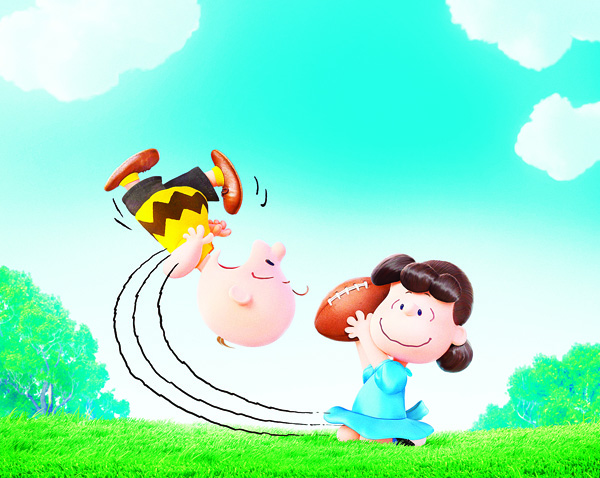03/11/2015
03/11/2015
 In this photo provided by Twentieth Century Fox & Peanuts Worldwide LLC, Charlie Brown and Lucy play in the new film, ‘The Peanuts Movie’. The movie releases in US theaters on Nov 6. (AP)
In this photo provided by Twentieth Century Fox & Peanuts Worldwide LLC, Charlie Brown and Lucy play in the new film, ‘The Peanuts Movie’. The movie releases in US theaters on Nov 6. (AP)You’re in love, Charlie Brown (and wouldn’t you know it, so is Snoopy). That’s the simple, slender premise behind “The Peanuts Movie,” Blue Sky’s gorgeous fan’sbest- friend adaptation of a comicstrip that is beloved by so many around the world, director Steve Martino’s biggest challenge was simply not to screw it up.
The late Charles M. Schulz almost surely would have appreciated the result, which presents a wholesome, goody-goody view of childhood emotional challenges barely advanced since his “li’l folks” first graced the bigscreen back in 1969’s “A Boy Named Charlie Brown,” apart from the risky move or transforming the cartoonist’s hand-drawn bobble-headed characters into complex computer-generated models of themselves — in 3D, no less.
While the old-fashioned story barely feels adequate to fill a halfhour TV special, the new look positions all involved to make as much in tie-ins and merch as they do in ticket sales. Over the course of nearly 90 minutes, incorrigible romantic Charlie Brown develops a crush on his new neighbor, the otherwise nameless (and until now, virtually faceless) Little Red-Haired Girl, while his high-flying beagle falls for a little pink-haired poodle named Fifi, an entirely new character he imagines rescuing from the Red Baron.
Both the boy and his dog set their goals high, though Snoopy has the self-confidence to follow through, while Charlie Brown suffers from near-constant insecurity — feelings exacerbated by longtime rival (and resident know-it-all) Lucy, who gladly enumerates his shortcomings, only to turn around and offer psychiatric help from her makeshift lemonade stand at a nickel a session.
Characters
For those who know the strip well, “The Peanuts Movie” should feel like the first day of a new school year, reunited with a classroom full of familiar faces. With the exception of Fifi (who looks like Snoopy with pink pom-pons stuck to her head and ears), everyone here is a well-established member of the Peanuts ensemble, and though their personalities come across ever so slightly different (more by virtue of voice casting than by design), the kid characters are performed by actual kids: Noah Schnapps for Charlie Brown, Hadley Belle Miller for Lucy and so on.
The grown-ups still speak via muffled trombone, while Snoopy and Woodstock’s voices have been resurrected from archival recordings by Bill Melendez, who directed nearly all the “Peanuts” features and TV specials (yet another of the pic’s many strategies for not straying far from the canon). Over the course of an often-repetitive 50-year run, Schulz’s haiku-like strips were inherently too short to develop much more than recurring dynamics or themes, so in narrative terms, the film is obliged to lean more heavily on the property’s many previous animated incarnations (with certain lines, like Lucy’s disgusted “I’ve been kissed by a dog!” lifted directly from “A Charlie Brown Christmas”).
What for adults will feel like nostalgia should play as fresh to younger auds, as they discover the origin of Snoopy’s Red Baron obsession, his invention of the Flying Ace character and his first appearance in Joe Cool mode. Meanwhile, carrying on futile pursuits that have dogged him for half a century, Charlie Brown struggles to fly his kite, fails to kick his football and repeatedly makes a fool of himself in school. One can only imagine the countless hours that must have been spent debating every little detail — from script to skin texture, the density of Pigpen’s dust cloud to the bounce of Frieda’s curls — although the creative team has been shrewd enough with nearly every one of its choices that audiences should have no trouble enjoying the film at face value.
After all, is there any face in cartoon history more apt than Snoopy’s to answer the classic joke, “What’s black and white and read all over?” Like most classic jokes, “Peanuts” isn’t so much funny as mildly amusing, which is evidently one of the many aspects of Schulz’s legacy that his son Craig and grandson Bryan fought to protect as screenwriters and producers on the film (evidently trumping genuinely hilarious collaborator Paul Feig). But a little modernization wouldn’t have hurt, especially in the diversity department. While Franklin remains Charlie Brown’s only brown friend, a non-white love interest would have been as progressive as Schulz’s tomboyish depiction of Peppermint Patty was back in the day.
From the very outset, following a version of the Fox fanfare delivered by none other than resident piano prodigy Schroeder, the film sets the stage with a hand-doodled snowfall: squiggly black balls loosely sketched in a rectangular frame, which fades from what could be one of Schulz’s comicstrip panels into a pleasantlooking CG alternative. As in “Horton Hears a Who!” (which Martino co-directed), we have entered a dynamic realm directly inspired by a visionary children’s artist, except that this time, instead of replicating the fantastical colors and creatures of Dr Seuss’ imagination, here we have the stripped-down, hyper-simplified Midwestern world of Charlie Brown, who is himself a glorified circle with ink-spot eyes, bulb-like nose and an unruly curlicue for hair. (RTRS)
By Peter Debruge


